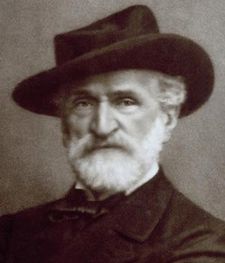Giuseppe Verdi
b Le Roncole, October 9 or 10, 1813; d Milan, January 27, 1901
Giuseppe Verdi was born in Le Roncole, a small village in the Duchy of Parma. Contrary to the composer’s claim that he was of illiterate peasants, Carlo and Luigia Verdi both came from families of landowners and traders – together they ran a tavern and grocery store. As a youth Verdi’s natural fascination with music was enhanced by his father’s purchase of an old spinet piano. By the age of nine he was substituting as organist at the town church, a position he would later assume and hold for a number of years. Carlo Verdi’s contact with Antonio Barezzi, a wealthy merchant and music enthusiast from nearby Busseto, led to Giuseppe’s move to the larger town and to a more formalized music education. Lodging in his benefactor’s home, Verdi gave singing and piano lessons to Barezzi’s daughter, Margherita, who later became the composer’s first wife.
Encouraged by his benefactor, Verdi applied to the Milan Conservatory, his tuition to be funded in part by a scholarship for poor children and the balance to be paid by Barezzi. The Conservatory rejected his application because of his age and uneven piano technique, but Verdi remained in Milan under the tutorship of Vincenzo Livigna, a maestro concertatore at La Scala. After making a few useful contacts in Milan, writing a number of small compositions and some last-minute conducting substitutions, Verdi was offered a contract by La Scala for an opera, Rocester. It was never performed, nor does the score appear to exist. It is commonly believed that much of the music was incorporated into his first staged opera, Oberto. The score also may have been destroyed with the composer’s other juvenilia as Verdi had requested in his will.
Oberto achieved modest success and Verdi was offered another commission from La Scala for a comedy. Unfortunately, by this time the composer had suffered great personal loss – in the space of two years his wife and two small children had all died. Verdi asked to be released from his contract, but La Scala’s impresario, Bartolomeo Merelli (probably with good intentions) insisted that he complete the score. Written under a dark cloud, Il regno di giorno failed in the theater, and Verdi withdrew from any further engagements. It was due to a chance meeting with Merelli (with a new libretto in tow) that led to his return to the stage. Nabucco was a huge success and catapulted Verdi’s career forward.
Italian theaters at this time were in constant need of new works. As a result, competent composers were in demand and expected to compose at an astonishing rate. Both Rossini and Donizetti had set the standard and Verdi was required to adapt to their pace. These became his “anni di galera” (years as a “galley slave”) – between 1842 and 1853 he composed eleven new operas, often while experiencing regular bouts of ill-health. His style progressed from treating grandiose historical subjects (as was the custom of the day) to those involving more intimate, personal relationships. This transition is crowned by three of his most popular works: Rigoletto, Il trovatore and La traviata.
Toward the end of the 1840s Verdi considered an early retirement, as his predecessor Rossini had done. He purchased land near Busseto once belonging to his ancestors and soon began to convert the farmhouse into a villa (Sant’Agata) for himself and his new companion, Giuseppina Strepponi, a retired soprano who had championed his early works (including Nabucco, for which she had sung the leading female role). Verdi had renewed their friendship a few years before; when Verdi and Strepponi were in Paris they openly lived together as a couple. After their return to Italy, however, this arrangement scandalized the denizens of Busseto, necessitating a move to the country.
As Verdi became more interested in farming and less involved in the frustrating politics of the theater, his pace slowed – only six new works were composed over the next 18 years. His style began to change as well, from the traditional “numbers opera” to a more free-flowing, dramatically truthful style. Some of his greatest pieces belong to this era (Simon Boccanegra, Un ballo in maschera, La forza del destino, Don Carlos), which concluded with what most thought was his swan song, the spectacular grand opera Aida.
Following Aida, Verdi firmly stated he had retired for good. He was now devoted to Sant’Agata, and to revising and remounting several earlier works, pausing briefly to write a powerful Requiem (1874) to commemorate the passing of Italian poet and patriot Alessandro Manzoni. Coaxed out of his retreat by a lifelong love of Shakespeare, the septuagenarian composer produced Otello and Falstaff to great acclaim.
Verdi’s final years were focused on two philanthropic projects, a hospital in the neighboring town of Villanova, and a rest home for aged and indigent musicians in Milan, the Casa di Riposo. Giuseppina (who Verdi had legally married in 1859) died in 1897, and Verdi’s own passing several years later was an occasion of national mourning. One month after a small private funeral at the municipal cemetery, his remains were transferred to Milan and interred at the Casa di Riposo. Two hundred thousand people lined the streets as the “Va, pensiero” chorus from Nabucco was sung by an eight-hundred-person choir led by conductor Arturo Toscanini.
